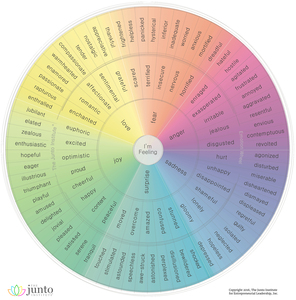The Feeling Wheel

By growing our emotional vocabulary, we can better identify our emotions, and check in with ourselves. Doing so can help bring a level of self-awareness, and a better understanding of others.
Goal
Learn clearer ways to describe our emotions
Build our emotional vocabulary
Develop emotional awareness
Materials
Instructions
Articulating our emotions can be a challenge, by using Robert Plutchik's Feeling Wheel, we can find clearer expressions to best align with our current mood.
1. The facilitator sets the tone by explaining that we will spend a couple of minutes reflecting on how we currently feel. They will note that all emotions are valid, and everyone's feelings are important.
2. The group look at the Feeling Wheel, and each use a sticker or post-it to identify which feeling is the closest they feel at the present moment.
3. Present an opportunity to share if people feel comfortable in doing so:
Each person takes a turn to speak through their emotion and why they might be feeling that way. They might consider if there are other surrounding feelings on the wheel that are similar to their current state. They can take into consideration the "root emotion" at the center of the wheel and if that feels the same, or how it differs.
4. Close the activity by thanking everyone for sharing.
Modifications
- the activity could be modified to suit imaginary scenarios, "How might we feel when...?"
- the exercise could follow a daily journal of a person, reflecting on their various moods throughout the day that they could share with their team.
Attachments
- feeling wheel.jpeg
Background
We are using Robert Plutchik's Feeling Wheel to identify our emotions: https://www.visualcapitalist.com/a-visual-guide-to-human-emotion/
Author
I'm the community and partnerships manager at SessionLab. I’ve helped community initiatives and NGOs tackle complex problems through facilitated design thinking workshops. As a lifelong learner, you’ll find me hosting SessionLab community events featuring guest facilitators, trainers and coaches sharing their experiences. My first career was as a creative project manager, producing visual merchandising solutions, retail interiors and window displays in London, and then eco-friendly artisanal products in Guatemala city. I love finding inspiration in unexpected places. I'm currently renovating an old house and potting plants to grow a beautiful garden.
More about author